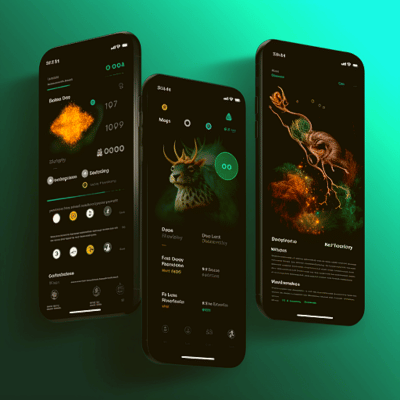In the digital era, a mobile app portfolio is no longer just an option; it’s a necessity. Whether you’re a seasoned developer or just starting in the world of app creation, showcasing your skills and projects is critical to stand out in the competitive landscape. In this blog post, we’ll dive into the essentials of creating the perfect mobile app portfolio, examine top designers’ portfolios, and explore how to turn your ideas into successful apps. Buckle up and get ready to unlock the true potential of your mobile app design expertise!
A mobile app portfolio is a collection of mobile apps you’ve created, showcasing your expertise and talents in the industry. It can be presented through a website, a mobile app, or a document, allowing potential clients to see the breadth of your skills and experience. But what makes a portfolio effective? It’s all about having a clear description of the project, showcasing screenshots of the app, providing links to the app store and source code, and incorporating client testimonials and case studies that demonstrate your expertise.
With the right portfolio, you can attract new clients, build brand loyalty, and foster strong relationships with your customers. Now, let’s explore why a mobile app portfolio matters and the essential elements that will make your portfolio shine.
A well-crafted mobile app portfolio is vital for several reasons. First, it highlights your technical skills, design capabilities, and experience working on diverse projects and platforms. Your portfolio is like a visual resume, giving potential clients a glimpse of your creativity and ability to tackle a challenging project head-on.
Moreover, a mobile app portfolio helps build trust and brand loyalty with prospective clients. By showcasing your unique style and approach to app design, you demonstrate your commitment to delivering quality work, ultimately attracting new clients and forging long-lasting relationships.
When designing your mobile app portfolio, it’s crucial to focus on a few key elements. First, emphasize your technical abilities, design prowess, and industry experience in the mobile app space. Include detailed descriptions of your projects, along with screenshots that showcase your app’s features and functionality. Don’t forget to identify your target audience by providing information on their demographics, interests, and needs. This will ensure your portfolio appeals to the right prospective clients.
Second, prioritize user experience, usability, and security in your portfolio. Make sure your app is easy to use and that the design is consistent across all platforms. By focusing on these essential elements, you’ll create an effective portfolio that captures the attention of potential clients and showcases your expertise in the mobile app design industry.

In the competitive landscape of mobile app design, some designers have managed to rise to the top. These top mobile app designers include Toptal, UX studio, Sunlight Media Ramotion, Blue Label Labs, Despark, Appinventiv, Hedgehog Lab, Savvy Apps, Lounge Lizard, Fueled, Big Drop Inc., Y Media Labs, InnovationM, and Sketch. Their portfolios are a testament to their skills and dedication to creating outstanding mobile apps.
Studying the portfolios of these top designers can provide valuable insights and inspiration for your own work. From sleek designs to innovative solutions, these portfolios showcase the best in mobile app design. Let’s take a closer look at some of the top iOS and Android app designers.
When it comes to iOS app design, there are several top designers who have made a name for themselves in the industry. Their portfolios include StockMarketEye, Seeking Alpha, PYTHEOS, Nitrogen, Unity, Wealthsimple Trade, and Sharesight, creating some of the best iOS app portfolios for managing stock portfolios.
These designers are known for their eye-catching designs, seamless user experiences, and innovative solutions to real-world problems. By examining their work, you can gain valuable insight into what makes a successful iOS app and apply those principles to your own projects.
For Android app designers, there’s no shortage of talent in the industry. The best Android app portfolios include StockMarketEye, Dolibarr, Seeking Alpha, PYTHEOS, Unity, Wealthsimple Trade, Active Trader Pro, Sharesight, CoinMarketCap, CoinGecko, Kubera, Coinbase, CoinTracker, Empower, Simplifi by Quicken, Mint by Intuit, Morningstar Instant X-Ray, Quicken Premier, Ziggma, iLEVEL, JStock, Inoreader, Investing.com, MSN Money, My Stocks Portfolio, StockTwits, Webull, Robinhood, SigFig Wealth Management, and Yahoo! Finance.
These portfolios showcase the designers’ expertise in creating visually appealing, user-friendly, and innovative Android apps. By studying their work, you can learn valuable lessons in what makes a successful Android app and incorporate those principles into your own projects.

Transforming your idea into a successful mobile app project requires more than just technical know-how. It demands collaboration with experienced designers who understand the target audience and can help bring your vision to life. Additionally, navigating the app development process is crucial to ensuring your project stays on track and meets the needs of your users.
In this section, we’ll delve into the importance of collaborating with designers and discuss the steps involved in the app development process. Get ready to unlock the opportunity to turn your ideas into successful mobile apps.
Working with designers offers numerous benefits, from injecting creativity into your project to ensuring your app is both visually appealing and user-friendly. Designers can help address potential issues, identify opportunities, and bring positive energy to the team. Furthermore, understanding the target audience is essential to creating an app that meets their expectations and provides an exceptional user experience.
Effective communication between designers, developers, and the target audience is critical to the success of your mobile app. Collaborating with designers ensures that your app meets the needs of your users and is delivered on time. So embrace the power of collaboration and watch your app idea come to life.
The app development process consists of several stages, including ideation, research, UX/UI design, development, testing, deployment, and support. Proper planning and execution are vital to avoid costly mistakes and delays, ensuring the success of your mobile app.
Research and UX/UI design play a significant role in making an app that genuinely meets users’ needs. Thorough testing, deployment, and support are essential to ensuring the app runs smoothly and addresses any issues that may arise after its release.
By understanding and navigating the app development process, you can turn your idea into a successful mobile app that users will love.

Client testimonials are a powerful form of social proof that can be used to demonstrate the quality of your work. By showcasing positive feedback from real customers who have experienced the value of your mobile apps, you can build trust and credibility with potential clients.
In this section, we’ll explore how to gather client testimonials and effectively display them in your mobile app portfolio. Harness the power of social proof to win new clients and boost your reputation in the industry.
There are several ways to gather client testimonials. One approach is to ask open-ended questions after a project or milestone, ensuring you ask the right questions that provide valuable feedback. You can also add a request form to your website using a form builder or customer feedback tool.
Additionally, you can search for reviews from past clients on platforms like Google, Yelp, social media, and web directories for local businesses. By gathering authentic testimonials, you can effectively demonstrate the value your mobile apps bring to clients.
Once you’ve collected client testimonials, it’s time to showcase them in your mobile app portfolio. Use quotes, videos, or screenshots to highlight the customer’s success story and emphasize key phrases or words by using bold, italic, or underline text.
Use colors, fonts, or icons to make testimonials pop and draw attention to the most important parts of the testimonial. By displaying client testimonials effectively in your portfolio, you can leverage the power of social proof to win over potential clients and showcase the impact of your work.

Case studies are an effective way to demonstrate your mobile app design expertise. By showcasing your ability to solve complex challenges and create innovative solutions, case studies provide potential clients with real-life examples of your work and prove your capabilities.
In this section, we’ll discuss how to select the right projects for case studies and craft compelling stories that effectively demonstrate your mobile app design expertise. Learn how to captivate your audience with case studies that stand out from the competition.
When selecting projects for case studies, it’s crucial to choose ones that showcase your skills and experience in the best way possible. Focus on projects that demonstrate your ability to solve difficult challenges, exhibit your creative and innovative side, and have a positive impact on the client’s business.
Choose successful projects that align with your company’s goals and objectives, as this ensures the case study is relevant to your target audience and showcases your expertise in a specific area. By selecting the right projects for case studies, you can effectively demonstrate your strengths and capabilities to potential clients.
To create an impactful case study, focus on telling a gripping story that highlights the client’s challenges, the solutions you provided, and the results they achieved. Include measurable results, such as increased revenue, improved customer satisfaction, or reduced costs, to back up your claims.
Use high-quality images, videos, and other visuals to bring the story to life. Emphasize key phrases or words using hard numbers, like percentages or dollar amounts, to support your claims. By crafting compelling case studies, you can effectively showcase your mobile app design expertise and win over potential clients.
In conclusion, creating the perfect mobile app portfolio is a crucial step in showcasing your skills and experience in the competitive world of app design. By paying attention to the essential elements of an effective portfolio, collaborating with designers, and utilizing social proof through client testimonials and case studies, you can unlock the full potential of your mobile app design expertise. So embrace these tips and techniques, and watch as your mobile app portfolio becomes a powerful tool for attracting new clients and solidifying your reputation in the industry.
Creating a successful mobile app doesn’t have to be daunting. Just follow these steps – start by setting the goal of your app, make a plan, do your research, create a wireframe, get your app designed, and test & launch your app.
With the right strategy and approach, you can design an amazing app that meets all your requirements!
What is mobile app design? It’s the process of creating an app from concept to completion that meets users’ needs in terms of usability, accessibility, engagement, and overall user experience. With careful consideration of the user journey, mobile app design creates an app that works beautifully on all devices.